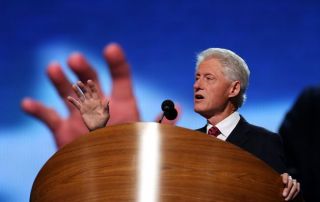Neuroscience
The Neuroscience of Speaking With Your Hands
Scientists discover why we gesticulate when speaking.
Posted July 5, 2013

Scientists have found that the evolution of the control of speech and hand movements can be traced back to the same place in the brain, which could explain why we use hand gestures when we are speaking.
How much do you use your hands when communicating? Hand gesturing is uniquely tied to speech from infancy. In fact, scientists observe the ability of infants as young as 18-months to use hand gestures as a predictor of later language abilities in healthy childhood development.
We all rely on hand gestures to augment the meaning of the words we are saying. Gesticulate is from the Latin “to gesture” and literally means “to make or use gestures, especially in an animated or excited manner with or instead of speech.” Researchers at Cornell University have traced the evolutionary roots of gesticulation back to a part of the hindbrain found in our ancestral origins that can still be found in fish.
Studies have found that the neural networks in the brain controlling the more complex vocal and pectoral mechanisms of social signalling among birds and mammals have their ancestral origins in a single compartment of the hindbrain in fishes. This begins to explain the ancestral origins of the neural basis for the close coupling between vocal and pectoral/gestural signalling that is observed among many vertebrate groups, including humans.
Professor Andrew Bass of Cornell, presented his findings at the meeting of the Society for Experimental Biology on July 3, 2013, saying: "We have traced the evolutionary origins of the behavioural coupling between speech and hand movement back to a developmental compartment in the brain of fishes. Pectoral appendages (fins and forelimbs) are mainly used for locomotion. However, pectoral appendages also function in social communication for the purposes of making sounds that we simply refer to as non-vocal sonic signals, and for gestural signalling."
Professor Bass said, "Coupling of vocal and pectoral-gestural circuitry starts to get at the evolutionary origins of the coupling between vocalization (speech) and gestural signalling (hand movements). This is all part of the perhaps even larger story of language evolution."
In my split-brain model of up brain-down brain, I associate the cerebrum (up brain) with cognitive processes and the hindbrain of the cerebellum (down brain) with muscle memory and subconscious processes. I have a theory that the feedback loop between hand movements and articulating ideas with your mouth creates a feedback loop between our conscious and subconscious minds.
Gesticulation helps access memories and ideas from every crevice of your mind and to turn abstract notions into logical words that flow from your mouth. I did a TV interview recently and it is obvious to me that I am using my hands throughout the interview to link up all parts of my brain and to turn thoughts into sentences. In fact, I think I gesticulate too much. It's annoying to watch.
A previous 2012 study by Spencer Kelly, associate professor of Psychology, director of the Neuroscience program, and co-director of the Center for Language and Brain at Colgate University found that gestures make people pay attention to the acoustics of speech. When you see a hand gesture, your auditory system expects to also hear speech. Kelly said, "Our results provide a glimpse into this past relationship by showing that gestures still have a tight and perhaps special coupling with speech in present-day communication. In this way, gestures are not merely add-ons to language – they may actually be a fundamental part of it."
Conclusion
A better understanding of the role that hand gestures play in how we learn and understand language could lead to new audio and visual instruction techniques to help people overcome major challenges with language delays and disorders. It could also help fine tune ways to make it easier to learn a second language.
What's next for the gesticulation researchers? Spencer Kelly said, “We're interested in how other types of visual inputs, such as eye gaze, mouth movements, and facial expressions, combine with hand gestures to impact speech processing. This will allow us to develop even more natural and effective ways to help people understand and learn language."


